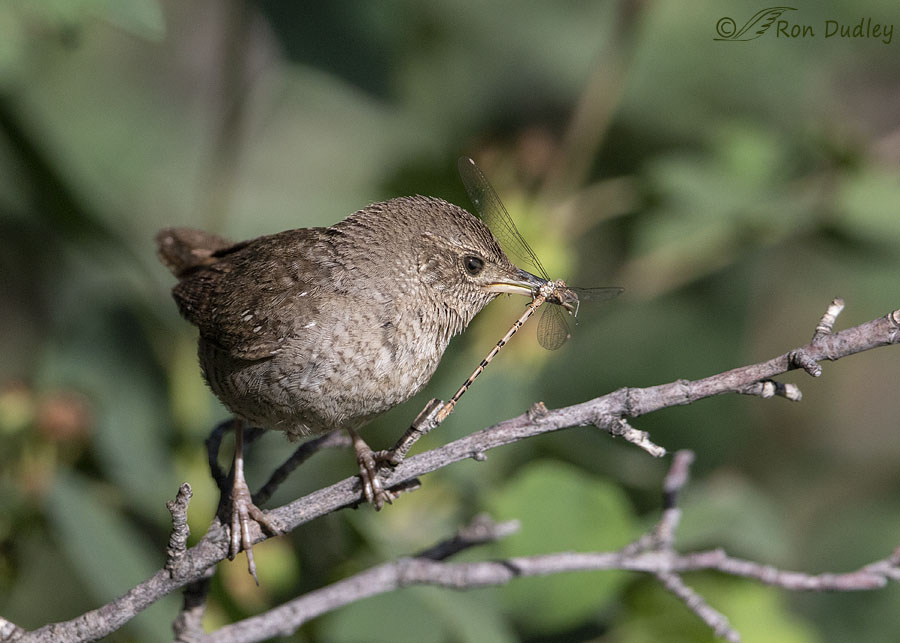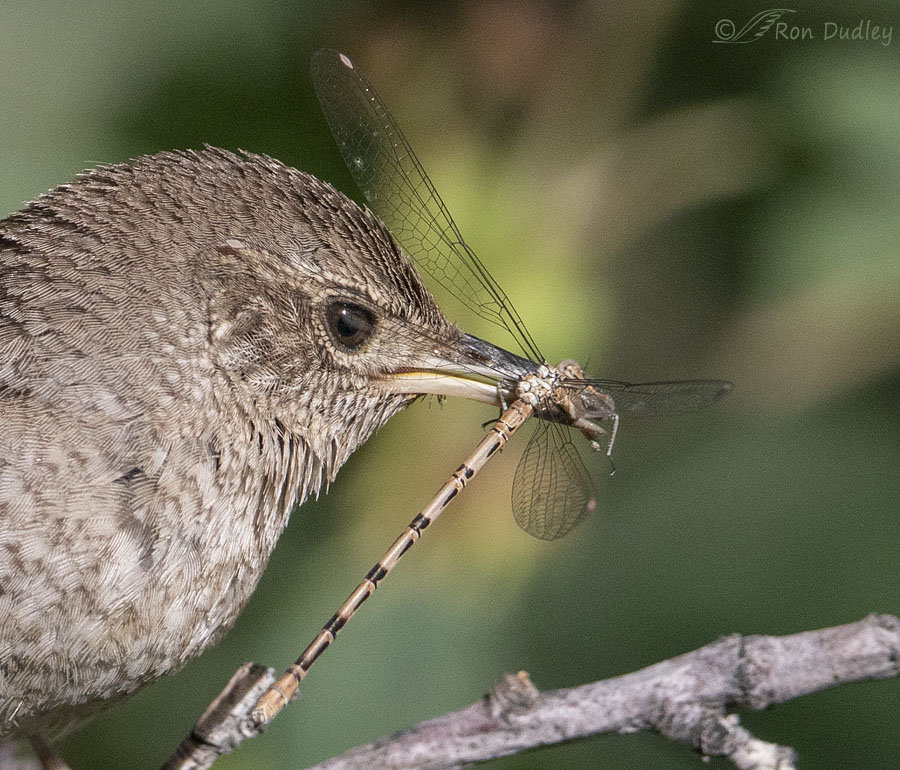A little help from my friends?

1/4000, f/5.6, ISO 800, Canon 7D Mark II, Canon EF 500mm f/4L IS II USM + EF 1.4 III Extender, not baited, set up or called in
Two days ago I spent some time in the mountains with a pair of House Wrens who were feeding youngsters in their nearby nest. Here one of them paused on a branch near the nest for a few moments before making the delivery. In this photo very little is sharp except for the head of the wren and the insect because I was close to the bird and shooting at f/5/6 which gave me very shallow depth of field.
I believe the insect is a damselfly but I’m no entomologist so I’m not even sure of that, much less what species it might be. If it is a damselfly it’s a species I’m unfamiliar with.

An extreme crop of the same photo reveals more detail.
Beyond the question of ID I actually find this version of the image more interesting than the previous one. For my tastes too much of the wren is out of focus in the first version and I love seeing the small details of the insect’s abdomen and wings. Notice that one of the wings extends over and behind the eye of the wren where it’s a little difficult to see but I think it creates a subtle but interesting visual effect. We’re actually seeing the eye of the bird through the wing of the insect.
Obviously the membranes between the veins in the wings are transparent and unless I’m mistaken (and I very well may be) those transparent membranes actually slightly magnify the tiny feathers behind them. If so, that surprises me. It’s probably unlikely that they do but every time I look at this version of the image that’s where my mind goes.
What say ye? Am I seeing things? It may be simply that those feathers behind the bird’s eye have a slightly coarser texture then the rest of the head feathers so they appear to be magnified when they’re not. Some of them are the feathers covering the ear opening so that very well may be the case.
Either way, is this a damselfly? Does anyone know the species? I’m also curious about those little spots near the distal ends of each wing.
Ron


It might be a female American Bluet damselfly. After that, there are many species. I like the veiled look on the Wren.
I am fond of the closer crop — I like the detail. I know we were talking about an entomologist last summer to whom you were sending a few shots with insects for ID. Of course, I cannot recall his name nor the name of his book. I have a mind like a sieve!
I prefer the more severely cropped version too, Marty. For the same reason.
Scrolling through the comments I am grateful that our different time zones mean that other much more knowledgeable people solved your mystery leaving me free to gaze in wonder.
Thank you all.
And from my throne of ignorance I vote for a slight magnification.
What would we do without those “more knowledgeable people”, EC? I for one would often be thoroughly lost.
Amazing sharpness in the cropped image. Can’t say I can detect any magnification from the wing. Perhaps it needs more distance from the bird.
Quite the hunter. I can’t seem to get within 10 feet of a damselfly or dragonfly before it goes airborne. But then I’m neither capable of flying or as quick as the the House Wren (or any bird I can think of).
Or maybe the magnification is just my overactive imagination, Lyle. It’s happened before…
Love this shot. Damselflies can close their wings. Dragonflies cannot. That’s the way I tell one from the other. More than that? Yeah…no. LOL
That’s the way I tell one from the other. More than that? Yeah…no. LOL
“Damselflies can close their wings. Dragonflies cannot.”
Arwen, that’s about all I know about telling the difference too.
The Order Odonata! One of my favorites… composed of Damselflies and Dragonflies. There is a textbook quality listing of all Odonata in N.America – I have to look up it’s name. I love Odonata but I gave my copy of the reference book away to another naturalist friend because the shear numbers of species, some of them very similar, were quite overwhelming. Now I remain content not knowing – except for my fave the Bluet of course.
While hamlecya camping with some Lakota friends, A young boy , about 10 , and I became friends. He offered to show me his special, secret place….a small, swampy, pond high in the mountains, suurounded by reeds…the air was swarming with bright, turquoise bue, iridescent damselflies…they were EVERYWHERE!!! It was ethereal!!! And was as purely magical as he said it would it be…
Interesting story, Patty. Thanks for telling it. He sounds like a neat kid.
Art, I’m doing well to just be able to distinguish damselflies from some of the other insects! ID to species is way over my head.
What a shot! I vote for a small amt of magnification.
I think so too, Sallie – though I’m far from sure of it.
Forgot to include the link:
http://greglasley.com/dragonnoramerix.html
Man, that’s a lot of damselfly species, Dave. Thanks for the link.
This looks like the one………. https://www.dragonfly-site.com/images/argia.jpg It is interesting that it’s wing does seem to magnify, clarify the feathers and eye underneath the wing…… Great capture, Ron. Lots of wrens around this year including one checking out an old woodpecker hole (probably a Downey). Hear them scoulding more than see them at times…….
Lots of wrens around this year including one checking out an old woodpecker hole (probably a Downey). Hear them scoulding more than see them at times……. 
It looks very similar, Judy. Could be…
Hi Ron. I sent the photo to John Acorn, an entomologist in Edmonton. Here’s what he said. “ Yep,a damselfly and a female at that. Looks like the genus Argia and I would guess Argia vivida. Nice shot indeed.” So there you have it. Thanks for the challenge.
Wayne
Wayne, based on your comment I did a little research and yes, it looks like a female Vivid Dancer, Argia vivida. Interesting that the males of the species are so blue in contrast to the females. Thanks very much to both you and John Acorn for your extra efforts.
Curiosity piqued, I took a look at a listing of damselflies and my oh my what a lot of them there are, not sure if blue darner is an official name or just something I grew up with. Anyway, here’s a link to a nice site with damselfly listing and nice images for each type. I’m off to chase osprey this morning and hoping the coastal overcast breaks soon.
I vote for the slight magnification by the wing membrane due to the apparent effect being so even across the wing-lensed area. What a great shot. I’ve never seen that coloration on a damselfly out here in the southern part of the pacific northwest. I think Blue Darners are our mot common damselfly and they are all over the place.
It was a new damselfly coloration for me too, Dave but I’ll admit that in the past I haven’t paid as much attention to them as I should. That’s about to change.
I’m curious, too– field guide no help, but those white spots are intriguing– those spots are invariably black, in both dragonflies and damselflies, as far as I know–
hope someone in your audience knows something about this insect– seems to be a “spreadwing” damselfly, given the very narrow stalk where the wing enters the thorax ?
Someone DID know, Kris – or at least they knew how to find out. Check out the comment from Wayne Lynch, above.
Well I do really like this photo…especially the fascinating area highlighted by the damsel’s wing. It certainly gives a somewhat magnified look, slightly darkened to the feathers underneath it. And seeing the veination of the damsel’s wing also fascinating. this was the area that first captured my eye and interest! I can’t help with ID as my book by Robert DuBois only covers damsels from Minnesota, Wisconsin and Michigan but I think you are referring to the stigma on the near tips of the wings. He says of these ‘ the pterostigma, or stigma for short, a blood filled cell of uncertain aerodynamic function near the tip of each wing…the shape and color of the stigma is often useful in identification’. They are interesting creatures to read about…their wing venation is beautiful.
I can’t help with ID as my book by Robert DuBois only covers damsels from Minnesota, Wisconsin and Michigan but I think you are referring to the stigma on the near tips of the wings. He says of these ‘ the pterostigma, or stigma for short, a blood filled cell of uncertain aerodynamic function near the tip of each wing…the shape and color of the stigma is often useful in identification’. They are interesting creatures to read about…their wing venation is beautiful.
Thanks for that info on the stigma, Kathy. Fascinating!
Marvelous shots Ron!
Charlotte
Thanks, Charlotte.
Nice photos Ron. I like these little House Wrens we have quite a few of them around at least at one of our lakes. No expert on Dragon Flies, but I have taken many photos of them and enjoy watching their flights over the water. I have sometimes sent Dragonfly photos to an entomologist at ASU in Phoenix for identification. I will try him, but of course being summer he may be away.
Thanks, Everett. I’ve been watching these wrens for a while – they’re sure energetic little birds.